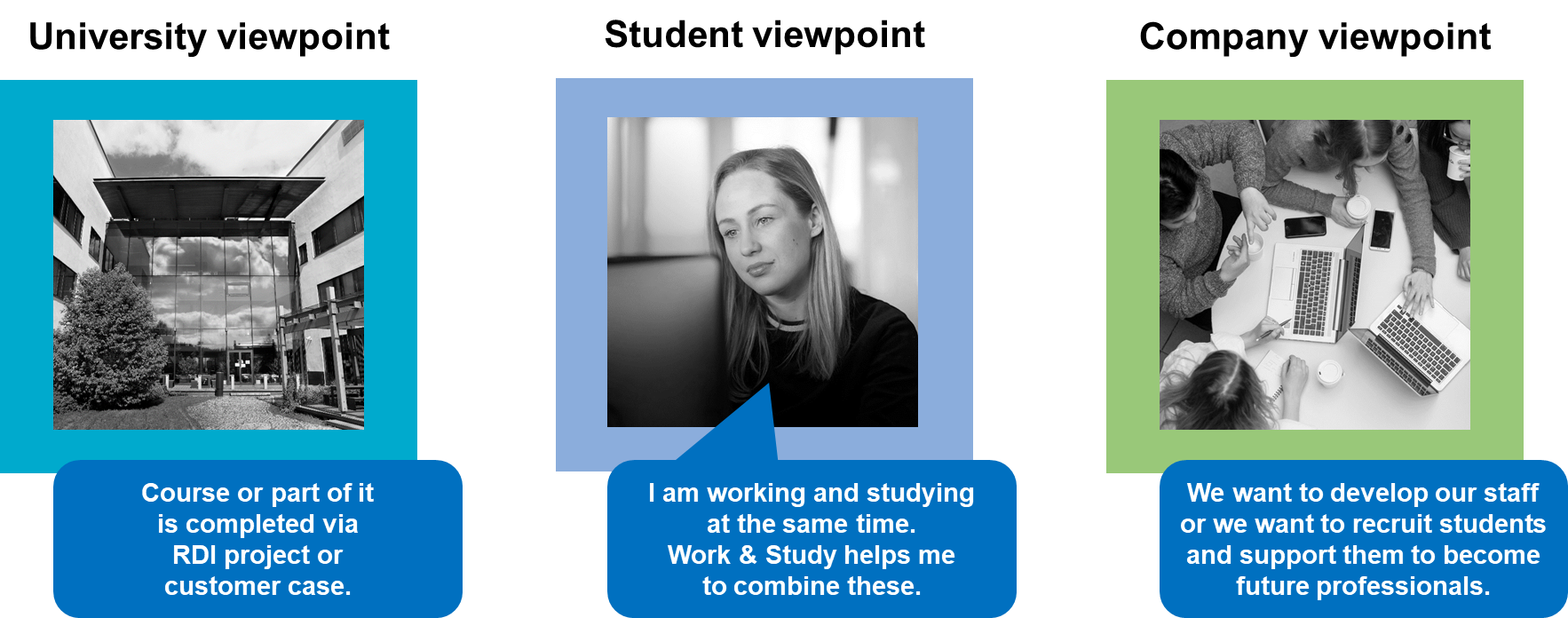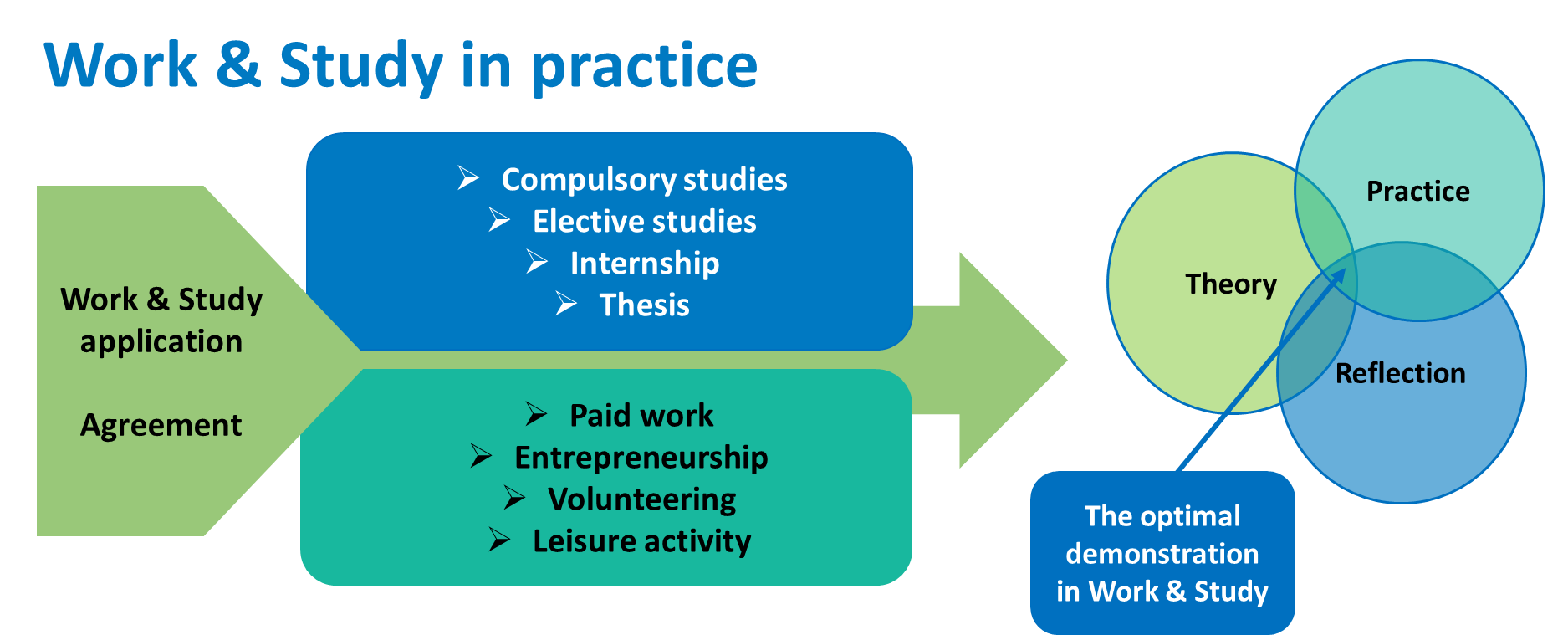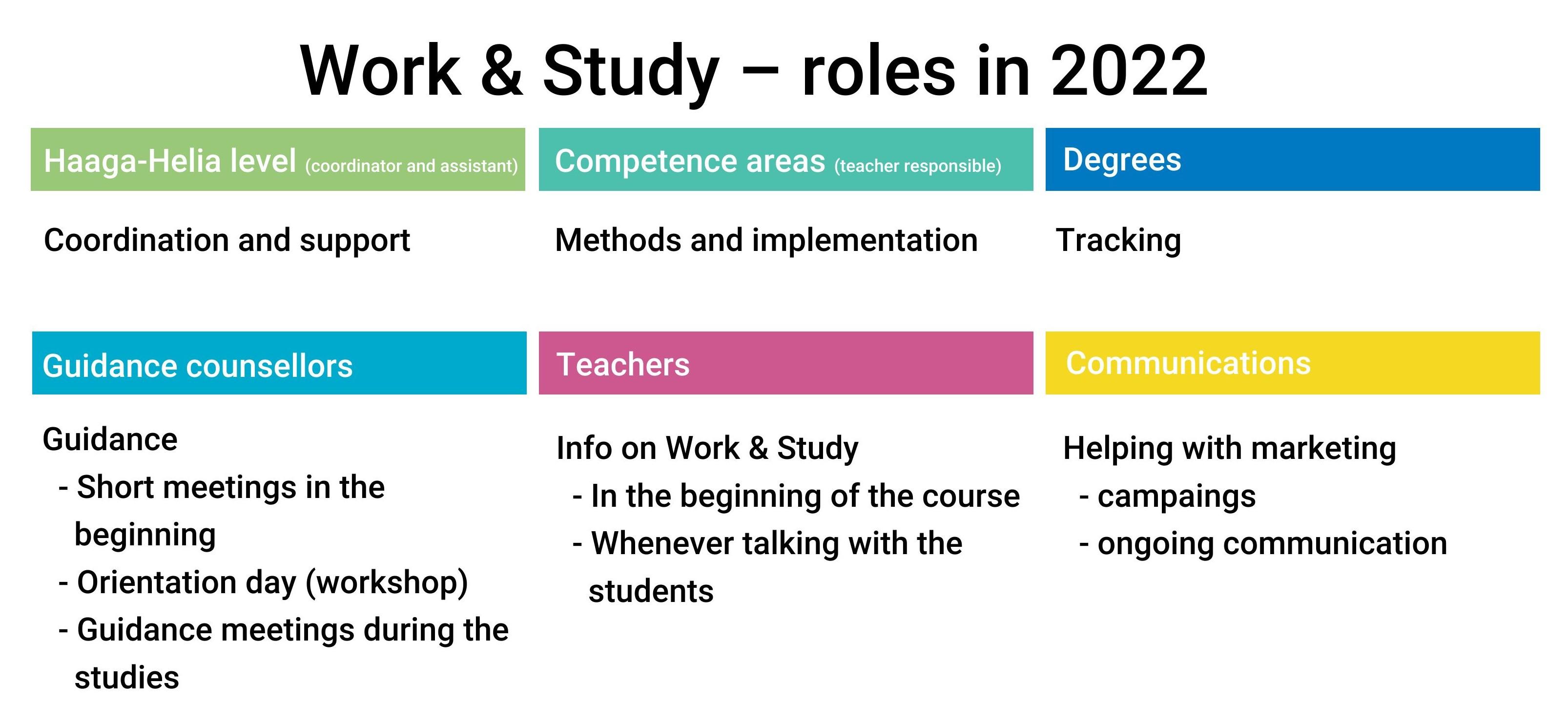The challenge of combining studying and working
It is common for students to work during their studies, especially in the Helsinki metropolitan area. Most of them receive student aid, which sets restrictions on working. Recently, the threshold for student aid has risen, thereby making work a more viable option for many. Due to this, the demand for flexible studies and continuous learning options is on the rise.
According to the Alumni Survey of 2020, 82.5% answered yes to the question “Did you work during your studies (other than work placement)?”. Similarly, 67% answered yes to the question “Did your work (other than work placement) during your studies to support the growth of your expertise in your field of studies?”. Based on this information, the Work&Study model was created. It offers a way of integrating work and learning and helps students to graduate on time.

Picture 27. Works&Study benefits all stakeholders
Recognising competences through the new model
Work&Study means that the learning goals are achieved by working and connecting the practical work with a theme-related knowledge base. In addition to paid work, entrepreneurship, volunteering or leisure activity can be applied to the model. Students can complete both compulsory and elective studies through work-based learning if the work supports their degree’s learning goals.

Picture 28. Works&Study in practice
The development process started in 2014, and over the years it has been improved to better serve our students. Since 2017, it has been used to some extent in all degree programmes. The Work&Study model has been developed and disseminated with project funding and our model is well known throughout the UAS and higher education pedagogy community. We receive ideas and comments on the model from students, stakeholders and teachers and it is further developed based on the feedback.
Communication and equal opportunities need to be developed
In 2022-2023 there will be some changes in the use of the model, due to our education reform and organisational changes. The education reform has slowed down the process during the last few years, but the new organisation and curricula will support the implementation of Work&Study.
We have identified, as key challenges, the ambiguities and misunderstandings surrounding the model, student equality, and communicating about the possibility of Work&Study. Equality relates to procedural differences between our competence areas and degrees. We need to improve the communication and dissemination of the model to both staff and students.
There are also challenges due to the revised organisation and lack of clear resources to guide the processes. Due to this, teachers have even had a negative attitude towards the model. In 2022, Work&Study is centralised to the competence areas, under the supervision of nominated teachers. Hopefully this clarifies resourcing. Currently, we do not have reliable monitoring of the credits completed through the model, as this is dependent on entries in the study administration system.
Our students feel that they do not have equal opportunities to complete studies through Work&Study, as the requirements for the same course can vary greatly depending on the teacher. Some teachers are not clear about the requirements and may demand too much from students. We aim to address this challenge by centralising the guidance to the nominated teachers.
Competence counselling teachers to address the challenges
The supervision of Work&Study projects will be transferred to the competence counselling teachers during 2022. The competence counselling teacher is a new role, responsible for the recognition of learning in their competence area. Coordinating the demonstration of competences and the Work&Study process in their own competence area enables them to better address potential problems.
The communication of the Work&Study model will be improved. We will clarify what we do and how we guide students, as well as communicate in a more targeted way. Once the teachers responsible for the guidance have been identified and we know to which students and at which stage of their studies the model is most relevant, we can target our messages better.

Picture 29. Works&Study roles
Work&Study successfully applied in the new curricula and organisation
The strengths of the Work&Study model include our new organisation, our highly knowledgeable and experienced teachers, the group-based Work&Study approach developed in-house, and the Work&Study pathways for continuous learning.
Key successes include embedding the recognition of learning and Work&Study model in the new curricula and organisation. It is crucial that the model is implemented in a meaningful way as part of our activities, while being clearly presented to students as a way of completing their studies.
The model has been developed and implemented for several years. We have highly experienced teachers who have counselled many Work&Study projects and are qualified to do the assessment. We are pioneers in learning by doing in higher education, reflected in the fact that other HEIs in Finland and abroad have purchased our training sessions on the recognition of learning and Work&Study.
In the group-based Work&Study model, students undergo the process in small groups, mentor each other and share their learning diaries. Even when the participants are from different fields, group work is useful in giving general peer support.
The Work&Study Continuous Learning pathway brings together experienced professionals without a higher education degree. The pathway enables them to complete the first year of their degree studies smoothly, using evidence-based learning and the Work&Study model. The idea is to use their own work as a way to proceed in their studies.
| Strengths | Enhancement areas |
| The new organisation supports Work&Study | Implementing the model across the organisation |
| Many active teachers who are experts in Work&Study | Equality among students through offering the same possibilities in all programmes |
| New variations: Work&Study Group and Work&Study Path | Raising awareness of the model |